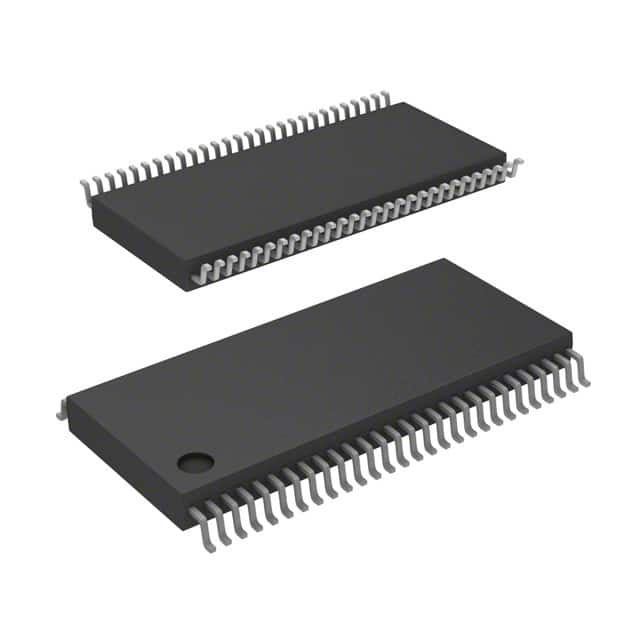Viz Specifikace pro podrobnosti o produktu.

Encyclopedia Entry: 74ALVC16501MTD
Product Overview
Category
The 74ALVC16501MTD belongs to the category of integrated circuits (ICs) and specifically falls under the family of digital logic devices.
Use
This IC is commonly used in electronic systems for data storage, transfer, and manipulation. It serves as a 16-bit universal bus transceiver with 3-state outputs.
Characteristics
- High-speed operation: The 74ALVC16501MTD operates at a high clock frequency, making it suitable for applications requiring fast data transfer.
- Wide voltage range: It supports a wide supply voltage range, allowing compatibility with various systems.
- 3-state outputs: The IC features 3-state outputs, enabling multiple devices to share a common bus without interference.
- Low power consumption: It is designed to consume minimal power, making it energy-efficient.
Package and Quantity
The 74ALVC16501MTD is available in a surface-mount package known as TSSOP (Thin Shrink Small Outline Package). It typically comes in reels or tubes containing a specific quantity, such as 250 or 1000 units per package.
Specifications
- Supply Voltage Range: 1.2V to 3.6V
- Input/Output Voltage Range: 0V to VCC
- Operating Temperature Range: -40°C to +85°C
- Maximum Clock Frequency: 200 MHz
- Number of Pins: 56
- Logic Family: ALVC (Advanced Low-Voltage CMOS)
Pin Configuration
The pin configuration of the 74ALVC16501MTD is as follows:
+---------------------+
OE1 |1 56| VCC
OE2 |2 55| GND
DIR |3 54| D1
D0 |4 53| D2
D3 |5 52| D4
D5 |6 51| D6
D7 |7 50| D8
D9 |8 49| D10
D11 |9 48| D12
D13 |10 47| D14
D15 |11 46| D16
G1 |12 45| G2
GND |13 44| GND
D17 |14 43| D18
D19 |15 42| D20
D21 |16 41| D22
D23 |17 40| D24
D25 |18 39| D26
D27 |19 38| D28
D29 |20 37| D30
D31 |21 36| D32
VCC |22 35| VCC
D33 |23 34| D34
D35 |24 33| D36
D37 |25 32| D38
D39 |26 31| D40
D41 |27 30| D42
D43 |28 29| D44
+---------------------+
Functional Features
The 74ALVC16501MTD offers the following functional features:
- Bidirectional data transfer: It allows data to be transmitted in both directions, enabling efficient communication between different parts of a system.
- 3-state outputs: The IC supports three output states - high impedance, logic high, and logic low. This feature facilitates bus sharing and prevents data conflicts.
- Output enable control: The OE1 and OE2 pins control the output enable function, allowing the user to enable or disable the outputs as needed.
- Direction control: The DIR pin determines the direction of data flow, enabling flexible data routing.
Advantages and Disadvantages
Advantages
- High-speed operation enables fast data transfer.
- Wide voltage range ensures compatibility with various systems.
- 3-state outputs facilitate bus sharing without interference.
- Low power consumption contributes to energy efficiency.
Disadvantages
- Limited number of pins may restrict the complexity of applications.
- Sensitive to electrostatic discharge (ESD) due to its integrated circuit nature.
Working Principles
The 74ALVC16501MTD operates based on CMOS technology. It utilizes a combination of transistors and logic gates to perform data storage, transfer, and manipulation functions. The IC's internal circuitry allows bidirectional data flow and provides control signals for output enable and direction.
Application Field Plans
The 74ALVC16501MTD finds application in various electronic systems, including but not limited
Seznam 10 běžných otázek a odpovědí souvisejících s aplikací 74ALVC16501MTD v technických řešeních
Sure! Here are 10 common questions and answers related to the application of 74ALVC16501MTD in technical solutions:
Q: What is the function of the 74ALVC16501MTD? A: The 74ALVC16501MTD is a 18-bit universal bus transceiver with 3-state outputs. It can be used for bidirectional data transfer between different voltage levels.
Q: What is the operating voltage range of the 74ALVC16501MTD? A: The 74ALVC16501MTD operates within a voltage range of 1.2V to 3.6V.
Q: Can the 74ALVC16501MTD handle level shifting between different voltage domains? A: Yes, the 74ALVC16501MTD is designed to handle level shifting between different voltage domains, making it suitable for interfacing between devices with different voltage requirements.
Q: How many bits can the 74ALVC16501MTD handle? A: The 74ALVC16501MTD can handle 18 bits of data.
Q: Does the 74ALVC16501MTD support 3-state outputs? A: Yes, the 74ALVC16501MTD supports 3-state outputs, allowing multiple devices to share a common bus without interfering with each other.
Q: What is the maximum data transfer rate supported by the 74ALVC16501MTD? A: The 74ALVC16501MTD can support high-speed data transfer rates up to several hundred megahertz (MHz), depending on the specific application and conditions.
Q: Can the 74ALVC16501MTD be used in both synchronous and asynchronous applications? A: Yes, the 74ALVC16501MTD can be used in both synchronous and asynchronous applications, providing flexibility in various system designs.
Q: Does the 74ALVC16501MTD have built-in ESD protection? A: Yes, the 74ALVC16501MTD incorporates built-in ESD protection, which helps safeguard against electrostatic discharge events.
Q: What is the power supply voltage tolerance of the 74ALVC16501MTD? A: The 74ALVC16501MTD has a power supply voltage tolerance of ±10%.
Q: Can the 74ALVC16501MTD be used in automotive applications? A: Yes, the 74ALVC16501MTD is qualified for automotive applications and meets the necessary standards and requirements.
Please note that these answers are general and may vary depending on the specific datasheet and application guidelines provided by the manufacturer.

